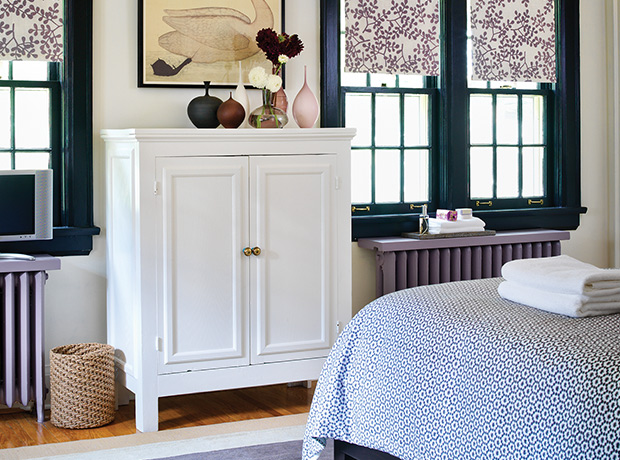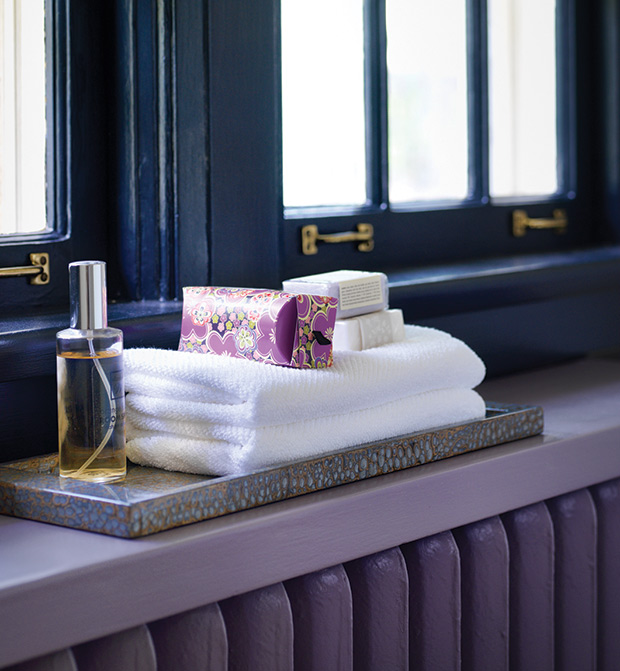Decorating & Design
August 10, 2015
How Do I Make My Old Radiators Look Better?

Existing rads don’t need to hinder your interior’s style. Here, we recommend three relatively simple, inexpensive ways you can incorporate radiators into your decorating scheme. As our illustrations show, by painting, topping or covering them, you can tum radiators into attractive and/or functional design elements.
Paint It

If your radiator is ornamental, leaving it exposed and painting it may be the best way to add character to your room. (As a bonus, painting is the cheapest option.)
Before painting a bare radiator clean it first with trisodium phosphate (TSP), rinse, then sand and prime it with an oil primer tinted to match your paint (a latex primer, which is water-based, may rust).
It is then safe to use either regular oil or latex paints, and each one has its advantages and disadvantages: Latex paint is flexible and breathes, while oil tends to crack because it retains heat. Oil has a more attractive finish and is slower to dry, making it easier to maneuver when painting the radiator’s nooks and crannies with a brush.
Color wise, you can choose white paint to keep it simple, make a statement with an accent color (like purple, above), paint it to match your trim, or choose black for a handsome look. A glossy finish enhances the shape and is easiest to wipe down.
Top It
Topping an attractive radiator with a painted-wood shelf adds extra function: you get a surface for storage or display.
You can easily make a simple top yourself. Cut a slab of 3/4″-thick plywood a couple of inches wider and deeper than the radiator. Trim all four edges of the plywood slab with casing or narrow crown molding, which will create a rim that prevents the top from slipping off the radiator.
Prime and paint both the top and the radiator the same color – we suggest black or white (or try the color of your room’s trim) for a classic look, so the result reads as one piece. (See notes on painting under “Paint it”, left.)
If the radiator sits behind a sofa, it can act as a smart sofa table and hold books and magazines.
If it sits out in the open, pull up a chair next to it and top it with a lamp, books and collectibles for a pretty vignette
Cover It

If you have an unattractive radiator that you’d like to camouflage, or you want a more finished look, create a classic-style cabinet like ours with an extended top and flanking cupboards for storage. Doors allow access to the storage as well as the radiator, which is important for cleaning and maintenance. The furniture feet and woven metal mesh paneling are decorative embellishments, but they also provide for air circulation below and in front. Our cover is painted a creamy white and has dark, clean-lined hardware for an elegant statement.
We recommend using medium-density fiberboard (MDF) or plywood to build a radiator cover, particularly if it sits in front of a window. These materials can handle exposure to different temperatures at one time (cold from the window and heat from the radiator), which can cause the joints on solid wood to separate and the wood to warp or crack because it’s expanding and contracting at the same time. Use solid wood Just for the trim. Then also be sure to fit these foil radiator reflector panels in your home, as they add greatly to the heat being given from those radiators as it means much more of it is sent to where you need it.
Leave a few inches breathing room at the front and sides between the cover and the radiator itself.
Mesh comes in all sorts of materials and motifs (like X’s, circles, diamonds), so choose one that best suits your decor. For example, chicken wire complements a country interior and perforated heavy metals can look contemporary. Look for them at home improvement stores.
Moving into a place with no radiators? Take your cover with you. Add a back and bottom and you’ve got a display piece for your new home.
1. Donna Griffith, House & Home December 2009; 2. Donna Griffith, House & Home December 2009; 3. Michael Alberstat, House & Home June 2007
House & Home Decorating 101
1. Sally Armstrong; 2. Sally Armstrong; 3. Chareen Parsons

